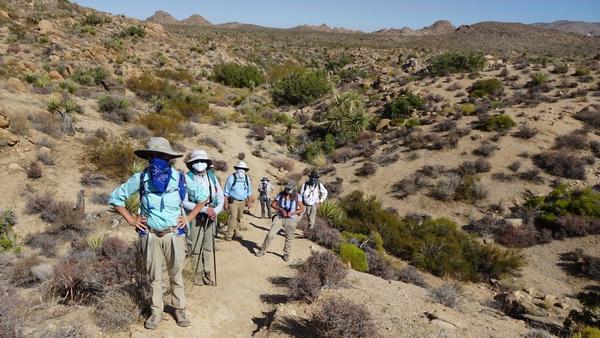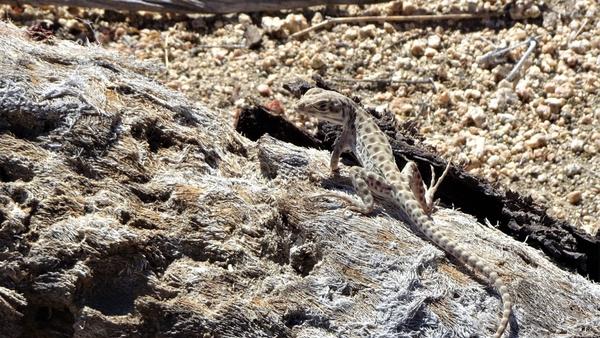Side-blotched lizards still have stories to tell
“Nature is the source of all true knowledge. She has her own logic, her own laws, she has no effect without cause nor invention without necessity”
— Leonardo da Vinci
There is joy in hiking a trail. Guilt over tasks not yet completed melts away. Double that joy when joined on the trail with a “community” of naturalists, adding insights and gained knowledge for every new sighting. Double that joy again when we are doing science.
As temperatures and aridity continue their upward path, our aim is to document how lizards in Joshua Tree National Park are responding to that change. Elsewhere scientists have already observed losses of lizard populations on arid mountain in Mexico. Will the same happen here, or will the lizards continue to inch up the mountainsides tracking the changing climate? We have already shown the National Park’s lizards are moving to higher elevations, but the bigger question is whether there is enough elevation in the Park to accommodate these lizards as this climate trajectory continues?
This past week I and my indispensable community science crew tackled the Park’s Maze Loop Trail, winding between boulders, junipers and Joshua trees, sticking close to about 4,000’ throughout. It is getting late in the season, and many of the adults of the larger lizards had already clocked in for their long winter’s sleep. Still, we could count chuckwallas due to their tell-tale plant-laden scat left at the crests of the boulders. And there were side-blotched lizards, our only native lizard that keeps going all winter long.
My affection for side-blotched lizards continues to grow. Because of their abundance relative to the other lizard species (so abundant data), and because they live so precariously; in just one year they must grow to maturity, avoid being eaten (every predatory lizard, snake and bird is on the lookout for a side-blotched meal), and then successfully breed. If they don’t, their lineage disappears. One of the interesting insights from this week’s survey was that these lizards were not evenly distributed along the trail, rather they are clumped, occurring in what appeared to be groups of 3-10 lizards over 10-50 meters, with sometimes several hundred meters in between with no lizards at all. Those groups represented lineages that would survive yet another year. The lizard-less gaps were perhaps the ghosts of lineages long gone. There was no obvious rhyme or reason for where there were lizard groups and where there were gaps. Perhaps we were seeing the expression of superior genes, those that could avoid predators, and whose females could find just the right spots to dig nests and lay their eggs that then had the best chance to survive.
Side-blotched lizards still have stories to tell. I’ve added a graph of their abundances over the past years at the higher elevations (> 4,000’) of the Park. Rainfall seems to matter. In dry years the populations go down, in wetter years they increase. But it is not that simple. In 2017, a wet year, these lizards were abundant on the Panorama and West End Loop Trails. In 2020, also a wet year, on those same trails their numbers were relatively low. Their population on the Maze Trail seems to stay fairly constant from year to year. And then on the Lost Horse Mine Trail they have gone from rare to super abundant – especially in the burned areas – in just three years. My guess, and at this point that is all it is, is that the unexpected, non-rainfall explainable, population changes are due to predator densities. The burned area, with low shrub cover, may have yet to attract the diversity of possible prey needed to sustain a “healthy” predator population. Until it does, perhaps the side-blotched lizards can survive and thrive in a relatively predator-free habitat.
“I am a firm believer that without speculation there is no good & original observation.”
— Charles Darwin
Finally, at about 4,000’ elevation, the Maze Trail is at the edge of where western fence lizards are typically found in the Park. I recorded one on this trail in 2016, but none since. We will keep looking, but it may be that they were not able to sustain the population here in the face of increased temperatures and aridity. They are still common at higher elevations.

